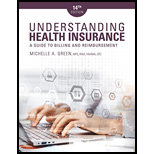
Understanding Health Insurance: A Guide to Billing and Reimbursement (MindTap Course List)
14th Edition
ISBN: 9781337554220
Author: Michelle A. Green
Publisher: Cengage Learning
expand_more
expand_more
format_list_bulleted
Question
error_outline
This textbook solution is under construction.
Knowledge Booster
Learn more about
Need a deep-dive on the concept behind this application? Look no further. Learn more about this topic, health-nutrition and related others by exploring similar questions and additional content below.Similar questions
- Occupational Hearing Loss Frequent exposure to loud noise of a particular pitch can cause loss of hair cells in the part of the cochlea that responds to that pitch. People who work with or around noisy machinery are at risk for such frequency-specific hearing loss. Taking precautions such as using ear plugs to reduce sound exposure is important. Noise-induced hearing loss can be prevented, but once it occurs it is irreversible because dead or damaged hair cells are not replaced. FIGURE 33.24 shows the threshold decibel levels at which sounds of different frequencies can be detected by an average 25-year-old carpenter, a 50-year-old carpenter, and a 50-year-old who has not been exposed to on-the-job noise. Sound frequencies are given in hertz (cycles per second). The more cycles per second, the higher the pitch. FIGURE 33.24 Effects of age aria occupational noise exposure. The graph shows the threshold hearing capacities fin decibels) for sounds of different frequencies (given in hertz) in a 25-year-okj carpenter (blue), a 50-year-old carpenter (red), and a 50-year-otd who did not have any on-the-job noise exposure (brown). 2. How loud did a 1,000-hertz sound have to be for the 50-year-old carpenter to detect it?arrow_forwardOccupational Hearing Loss Frequent exposure to loud noise of a particular pitch can cause loss of hair cells in the part of the cochlea that responds to that pitch. People who work with or around noisy machinery are at risk for such frequency-specific hearing loss. Taking precautions such as using ear plugs to reduce sound exposure is important. Noise-induced hearing loss can be prevented, but once it occurs it is irreversible because dead or damaged hair cells are not replaced. FIGURE 33.24 shows the threshold decibel levels at which sounds of different frequencies can be detected by an average 25-year-old carpenter, a 50-year-old carpenter, and a 50-year-old who has not been exposed to on-the-job noise. Sound frequencies are given in hertz (cycles per second). The more cycles per second, the higher the pitch. FIGURE 33.24 Effects of age aria occupational noise exposure. The graph shows the threshold hearing capacities fin decibels) for sounds of different frequencies (given in hertz) in a 25-year-okj carpenter (blue), a 50-year-old carpenter (red), and a 50-year-otd who did not have any on-the-job noise exposure (brown). 3. Which of the three people had the best hearing in the range of 4,000 to 6,000 hertz? Which had the worst?arrow_forwardOccupational Hearing Loss Frequent exposure to loud noise of a particular pitch can cause loss of hair cells in the part of the cochlea that responds to that pitch. People who work with or around noisy machinery are at risk for such frequency-specific hearing loss. Taking precautions such as using ear plugs to reduce sound exposure is important. Noise-induced hearing loss can be prevented, but once it occurs it is irreversible because dead or damaged hair cells are not replaced. FIGURE 33.24 shows the threshold decibel levels at which sounds of different frequencies can be detected by an average 25-year-old carpenter, a 50-year-old carpenter, and a 50-year-old who has not been exposed to on-the-job noise. Sound frequencies are given in hertz (cycles per second). The more cycles per second, the higher the pitch. FIGURE 33.24 Effects of age aria occupational noise exposure. The graph shows the threshold hearing capacities fin decibels) for sounds of different frequencies (given in hertz) in a 25-year-okj carpenter (blue), a 50-year-old carpenter (red), and a 50-year-otd who did not have any on-the-job noise exposure (brown). 4. Based on these data, would you conclude that the hearing decline in the 50-year-old carpenter was caused by age or by job-related noise exposure?arrow_forward
arrow_back_ios
arrow_forward_ios
Recommended textbooks for you
- Understanding Health Insurance: A Guide to Billin...Health & NutritionISBN:9781337679480Author:GREENPublisher:Cengage
 Medical Terminology for Health Professions, Spira...Health & NutritionISBN:9781305634350Author:Ann Ehrlich, Carol L. Schroeder, Laura Ehrlich, Katrina A. SchroederPublisher:Cengage Learning
Medical Terminology for Health Professions, Spira...Health & NutritionISBN:9781305634350Author:Ann Ehrlich, Carol L. Schroeder, Laura Ehrlich, Katrina A. SchroederPublisher:Cengage Learning Human Biology (MindTap Course List)BiologyISBN:9781305112100Author:Cecie Starr, Beverly McMillanPublisher:Cengage Learning
Human Biology (MindTap Course List)BiologyISBN:9781305112100Author:Cecie Starr, Beverly McMillanPublisher:Cengage Learning - Surgical Tech For Surgical Tech Pos CareHealth & NutritionISBN:9781337648868Author:AssociationPublisher:Cengage

Understanding Health Insurance: A Guide to Billin...
Health & Nutrition
ISBN:9781337679480
Author:GREEN
Publisher:Cengage

Medical Terminology for Health Professions, Spira...
Health & Nutrition
ISBN:9781305634350
Author:Ann Ehrlich, Carol L. Schroeder, Laura Ehrlich, Katrina A. Schroeder
Publisher:Cengage Learning

Human Biology (MindTap Course List)
Biology
ISBN:9781305112100
Author:Cecie Starr, Beverly McMillan
Publisher:Cengage Learning


Surgical Tech For Surgical Tech Pos Care
Health & Nutrition
ISBN:9781337648868
Author:Association
Publisher:Cengage

Medical Terminology | Lesson 8 | Nervous System, Cardiorespiratory and Endocrine Anatomy Terms; Author: JJ Medicine;https://www.youtube.com/watch?v=QiivC3iLZew;License: Standard YouTube License, CC-BY